  |
|
|
|
APPENDIX C
The
Business Cycle
This Appendix probes key
aspects of the implicate order1 of the business cycle (the
implicate order is discussed in more detail in Book
III). The important structural issues include:
- The distribution
pattern of bank-money (specifically, the pattern of overinvestments in
commercial real estate). The pattern at the largest bank is used to order
and calibrate the events we seek to investigate.
- The propagation of
the pattern through the economy. The unfoldment of the business cycle.
- The links and connections
(if any) between overinvestments in commercial real estate and:
- non-accrual business loans,
- non-accrual residential
mortgages,
- the number of business
bankruptcies,
- the unemployment rate,
- government net lending,
- the criminal code rate, and
- net income and dividends at
the largest bank.
The Charts demonstrate that
changes in the distribution of bank-money were not uncorrelated with changes in the
national economy. One troublesome finding must be pointed out: the changes in the
structure and distribution of bank-money appear to have had a major negative impact
on the economy.
|
|
| 1
For the concepts of implicate order, see David Bohm, Wholeness and the Implicate
Order, 1980. |
|
CAUSALITY AND RESPONSIBILITY
If it can
be demonstrated that speculative overinvestments (if any) had "strongly
injurious" (Schumpeter's expression) effects on the National economy, then:
- How should the responsibility
for these effects be partitioned and distributed?
- How should people
and businesses be compensated for any losses or damages they may have suffered as a
result (direct, indirect, collateral, etc.) of speculative overinvestments by others?
- What must
individuals, businesses, banks, and governments do to protect the Nation from the potential devastations of the next business cycle -- especially if these can trigger or cause catastrophic local or global
consequences (e.g., in the case of Canada, the breakup
of the country)?
|
|
THE
BUSINESS CYCLE
COMMERCIAL
REAL ESTATE LOANS |
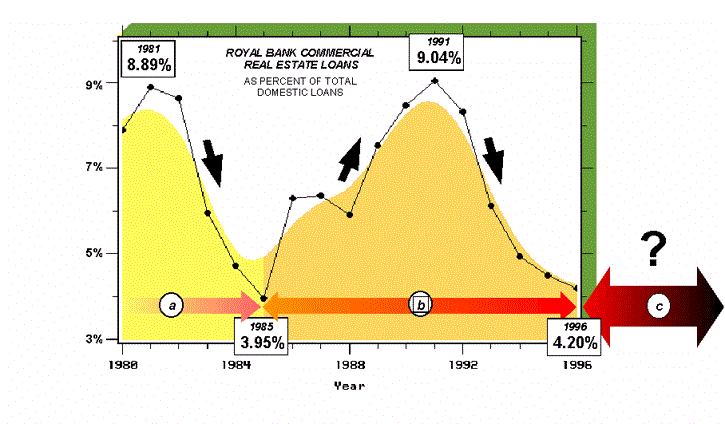
| CYCLE |
COMMERCIAL
REAL ESTATE LOANS |
| |
P
T |
PEAK
TROUGH |
$ MIL. |
% |
| a |
P
P
T |
1981
1982
1985 |
--
3,714
1,781 |
8.89
--
3.95 |
| b |
P
T
T? |
1991
1995
1996 |
7,098
4,334
-- |
9.04
--
4.20 |
| c |
P?
T? |
2002/3
2006/7 |
? |
? |
|
|
Plate C-1
The Business
Cycle: Commercial Real Estate Loans, as Percent of Total Domestic Loans -- The Royal Bank
of Canada, 1980-1996.What was the impact of
overinvestments in commercial real estate (if any) on Canadians? What caused the overinvestments
(monetary policy, credit creation, manipulation of interest rates, etc., as alleged by
some; or monopolistic practices1 and rapacious capitalism, as alleged
by others)? Did economic and social dislocations or devastations follow overinvestments?
To answer these questions, one must probe and investigate a variety of hypothesized
or potential creative destruction2 effects -- recessions, increases in
non-accrual loans, surges in business bankruptcies, increases in unemployment or
underemployment, decreases in personal saving, increases in personal and unincorporated
business debts, increases in governmental deficits, increases in the criminal code rate,
increases in government deficits or debts, transfer payments to families, etc. The effects
(if any) would have to be traced as if they were LINKS IN A CHAIN of economic and social events. The
links in the chain would have to be followed -- one link at a time, until a
complete picture of the hypothesized creative destruction process (if any) emerges.
But where do we start? How do we instantiate, order, and calibrate
the effects we seek to investigate? One possible solution is to start with the business
cycle (if any) at Canada's largest banks. The phases of the last two business cycles at
the Royal Bank (commercial real estate cycles a and b, for which data are available from
bank annual reports3) can be used to order and calibrate
some potential effects we seek to investigate. It must be pointed out that the Royal Bank
of Canada (Canada's largest bank) was not the only player that was involved in
overinvestments in real estate. The phases of the business cycle at Canada's top three
banks are compared in Plate B-2.
Note that cycle b had a duration of about 10 years and
that it incorporated a much shorter cycle that peaked in 1987, the year the stock market
crashed. If this cycle corresponds to Schumpeter's "short-run" cycle (lasting
about 9.5 years),4 then we should expect, in
Schumpeter's words, "strongly injurious" effects.
Note: underlying trend generated using smoothing (1x) and splining.
Sources:
1 On "monopolistic practices," see Joseph A.
Schumpeter, Capitalism, Socialism and Democracy (1942), with an Introduction by Tom
Bottomore, 3rd ed., 1942, 1947, 1950, and 1976, at 87-106 (Monopolistic Practices).
2 On "creative destruction," see Joseph A.
Schumpeter; Ibid.
3 Royal Bank annual reports (domestic commercial real
estate and total domestic loans, net of specific and general provisions, as at September
30).
4 Joseph A. Schumpeter, Capitalism, Socialism and
Democracy (1942), at 94 (nature, structure, and duration of short-term cycles
affecting recessions).
[Copyright © 1998 by MACROKNOW INC. All rights reserved.]
|
|
The
Business Cycle1
The
Link Between Overinvestments in Commercial Real Estate
and Business Non-Accrual Loans |
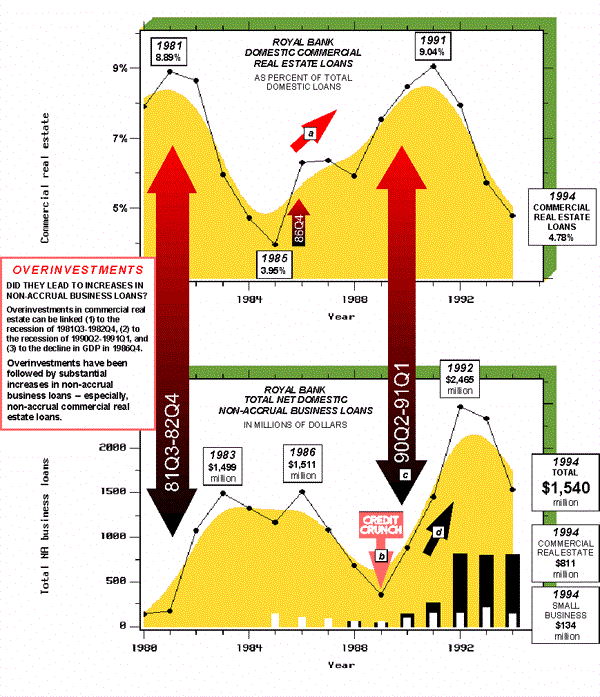 |
Chart C-1
The Business
Cycle: The Link Between Overinvestments in Commercial Real Estate, Recessions, and
Business Non-Accrual Loans -- Royal Bank of CanadaRoyal Bank domestic commercial real
estate loans swelled from $3,714 million in 1985 to $7,098 million in 1991. As a
percentage of total domestic loans, they swelled from 3.95% in 1985 to 9.04% in 1991
(arrow a). Overinvestments led to a
"credit crunch" at many banks, beginning around 1989 (arrow b). Simultaneous overinvestments at
banks and trust companies were followed by a recession (arrow c) and by substantial increases in
total net non-accrual business loans (arrow d). Royal Bank data are used to
calibrate business cycle curves. Data in percent and in millions of dollars.
Source: Royal Bank
annual reports (loans by industry, as at September 30; non-accrual loans, net of allowance
for credit losses, as at October 31).
[Copyright © 1998 by
MACROKNOW INC. All rights reserved.]
|
|
The
Business Cycle2
The
Link Between Overinvestments in Commercial Real Estate
and Non-Accrual Residential Mortgages |
 |
Chart C-2
The Business
Cycle: The Link Between Overinvestments in Commercial Real Estate and Non-Accrual
Residential Mortgages -- Royal Bank of CanadaRoyal Bank domestic commercial real
estate loans swelled from $3,714 million in 1985 to $7,098 million in 1991 (arrow a). Overinvestments led to a
"credit crunch" at many banks (arrow b). Simultaneous overinvestments at
banks and trust companies were followed by a recession (arrow c) and by substantial increases in
net non-accrual residential mortgages (arrow d). These were also followed by
substantial increases in the number of foreclosures.
Source: Royal Bank
annual reports (loans by industry, as at September 30; non-accrual loans, net of allowance
for credit losses, as at October 31).
[Copyright © 1998 by
MACROKNOW INC. All rights reserved.]
|
|
The
Business Cycle3
The
Link Between Overinvestments and Business Bankruptcies |
 |
Chart C-3
The Business
Cycle: The Link Between Overinvestments and Business BankruptciesExcessive channeling of loans into
commercial real estate (arrow a) led to a "credit crunch"
at many banks (arrow b), and was followed by a
recession (arrow c). Overinvestments were also followed
by substantial increases in non-accrual loans, and in the number of bankruptcies (arrow d).
Sources: Royal Bank
annual reports (loans by industry, as at September 30); and Consumer and Corporate Affairs
Canada, Bankruptcy Branch (number of business bankruptcies in Canada).
[Copyright © 1998 by
MACROKNOW INC. All rights reserved.]
|
|
The
Business Cycle4
The
Link Between Overinvestments and Unemployment |
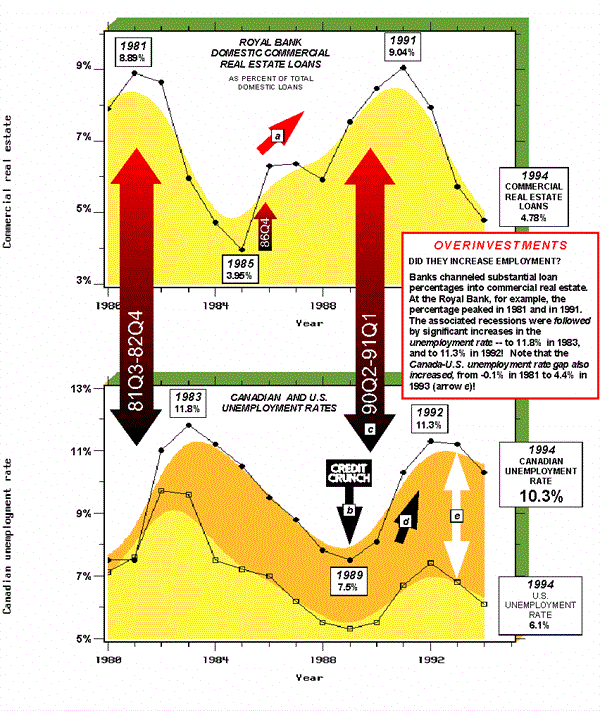 |
Chart C-4
The Business
Cycle: The Link Between Overinvestments and UnemploymentOverinvestments in commercial real
estate (arrow a) led to a "credit crunch"
at many banks (arrow b). Overinvestments were followed
by a recession (arrow c), by increases in non-accrual loans,
and by substantial increases in the number of bankruptcies. Jobs were lost. Unemployment
swelled (arrow d). Business and consumer failures,
corporate downsizing, etc., had devastating social effects.
Sources: Royal Bank
annual reports (loans by industry, as at September 30); and Economic Report of the
President, February 1995 (Department of Labor, Bureau of Labor Statistics: U.S. and
Canadian civilian unemployment rates).
[Copyright © 1998 by
MACROKNOW INC. All rights reserved.]
|
|
The
Business Cycle5
The
Link Between Overinvestments and Government Net Lending |
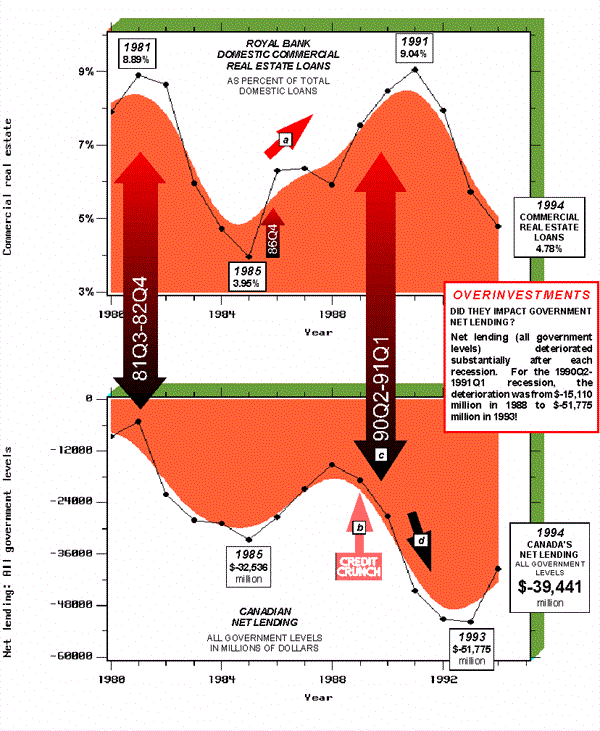 |
Chart C-5
The Business
Cycle: The Link Between Overinvestments and Government Net LendingOverinvestments in commercial real
estate (arrow a) culminated with a recession (arrow c). Substantial increases in
non-accrual loans and bankruptcies followed. Jobs were lost. Unemployment swelled.
As a percentage of total direct taxes, direct taxes from corporate and government business
enterprises fell. To deal with the devastations of the recession, transfer payments to
families were increased. Substantial increases in government net lending followed
(arrow d). (Net lending = Saving + Capital
consumption allowances - Investment in fixed capital and inventory.)
Sources: Royal Bank
annual reports (loans by industry, as at September 30); Statistics Canada, Canadian
Economic Observer, Historical Statistical Supplement 1994/95, Catalogue 11-210,
July 1995 (net lending, all government levels).
[Copyright © 1998 by
MACROKNOW INC. All rights reserved.]
|
|
The
Business Cycle6
The
Link Between Overinvestments and the Criminal Code Rate |
 |
Chart C-6
The Business
Cycle: The Link Between Overinvestments and the Criminal Code RateOverinvestments in commercial real
estate (arrow a) led to a "credit crunch"
(arrow b), and culminated with a recession
(arrow c). Increases in commercial real
estate loans were followed by increases in bankruptcies and by increases in
federal statute incidents reported to police (arrow d). Property crime rate
skyrocketed to over 1.7 million incidents in 1991! Crime rates in incidents per 100,000
population.
Sources: Royal Bank
annual reports (loans by industry, as at September 30); D. Hendrick, Canadian Crime
Statistics, 1994, Juristat, 15 (12), August 1995, Catalogue 85-002
(crime statistics) (cited source: Uniform Crime Reporting Survey, Canadian Centre for
Justice Statistics); Crime Trends in Canada, 1962-1990, Juristat, 12
(7), March 1992, Catalogue 85-002; and R. Kong, private communication (crime statistics).
[Copyright © 1998 by
MACROKNOW INC. All rights reserved.]
|
|
The
Business Cycle7
The
Link Between Overinvestments, Net Income, and Dividends |
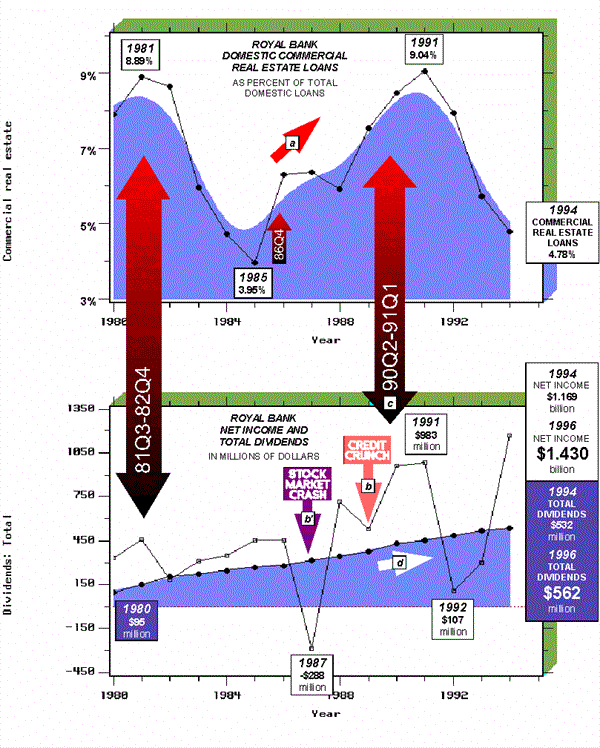 |
Chart C-7
The Business
Cycle: The Link Between Overinvestments in Commercial Real Estate, Net Income, and
Dividends -- The Royal Bank of CanadaOverinvestments in commercial real
estate (arrow a) led to a "credit crunch"
(arrow b), and culminated with a recession
(arrow c). While recessions, and the stock
market crash of October 19, 1987 (arrow b' ), appear to have
impacted the bank's net income, the graphs provide powerful evidence that neither the
overinvestments nor the recessions impacted the bank's ability to declare gargantuan
profits -- $1.169 billion in 1994, $1.262 billion in 1995, and $1.430 billion in 1996 --,
or to declare increasingly higher total dividends (arrow d). Net income and dividends in
millions of dollars.
Source: Royal Bank
annual reports (loans by industry, as at September 30; net income and dividends).
[Copyright © 1998 by
MACROKNOW INC. All rights reserved.]
|
|

|







